Click on images to enlarge
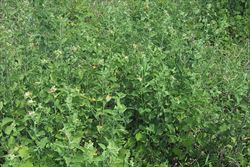
infestation (Photo: Chris Gardiner)
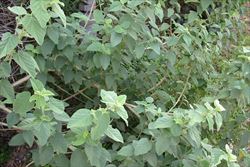
habit prior to flowering (Photo: Sheldon Navie)

habit in flower (Photo: Sheldon Navie)
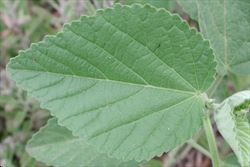
close-up of heart-shaped leaf (Photo: Sheldon Navie)

velvety hairy young leaves and stems (Photo: Sheldon Navie)

upper leaves and flower clusters (Photo: Sheldon Navie)
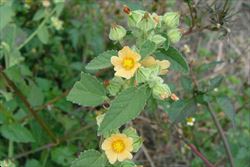
flowers with smaller and narrower upper leaves (Photo: Sheldon Navie)
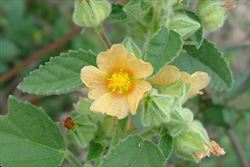
close-up of flower, showing the darker ornage spots at the base of the petals (Photo: Sheldon Navie)
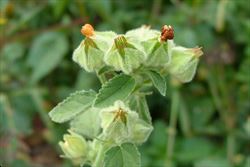
close-up of young fruit showing the hairy sepals (Photo: Sheldon Navie)

clusters of immature and mature fruit (Photo: Sheldon Navie)

close-up of mature fruit (Photo: Sheldon Navie)
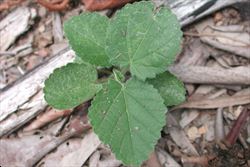
seedling (Photo: Sheldon Navie)
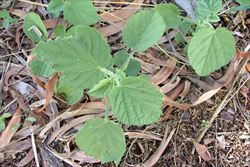
young plants (Photo: Sheldon Navie)
Scientific Name
Sida cordifolia L.
Family
Malvaceae
Common Names
bala, country mallow, flannel sida, flannel weed, flannelweed, heart leaf sida, heart-leaf sida, heartleaf sida, Indian country mallow, sida, white burr
Origin
This species is now widespread in the tropics (i.e. pan-tropical). Its origin is obscure, but it may have originated tropical America (and/or Africa).
Naturalised Distribution
This species is distributed mainly in the coastal and sub-coastal areas of Queensland and the Northern Territory and in the northern regions of Western Australia. Less common or scattered in other parts of Queensland and the Northern Territory, and in north-eastern New South Wales. Herbaria in Western Australia and Queensland consider this species to be naturalised, while in New South Wales and the Northern Territory it is sometimes considered to be native.
Also regarded as being naturalised on several Pacific islands (i.e. in French Polynesia, Hawaii, New Caledonia and Tonga).
Habitat
A weed of pastures, grasslands, open woodlands, crops, roadsides, disturbed sites, waste areas, gardens, footpaths and parks in tropical, sub-tropical and sometimes also semi-arid environments.
Habit
A long-lived (i.e. perennial) herbaceous plant or small shrub (i.e. sub-shrub) with upright (i.e. erect), branching stems. It usually grows 50-100 cm tall, but occasionally reaches up to 2 m in height.
Distinguishing Features
- an upright and long-lived herbaceous plant or small shrub growing 0.5-2 m tall.
- its wiry stems and leaves are densely covered in soft hairs that give them a felty texture.
- its leaves are usually heart-shaped with rounded tips and toothed margins.
- its yellow or pale orange flowers are clustered in the upper leaf forks or at the tips of the stems.
- these flowers have five petals (8-10 mm long) and five partially fused sepals that are densely hairy.
- its fruit (3-8 mm wide) separates into 8-10 wedge-like segments when mature.
- these one-seeded segments (2-2.5 mm long) are topped with two long and slender spines (2.5-3.5 mm long).
Stems and Leaves
The stems are usually slender and quite wiry, but sometimes they can be slightly woody in nature. Stems and leaves are densely covered in soft whitish-coloured hairs that give them a felty texture.
The leaves are alternately arranged and are borne on stalks (i.e. petioles) 1-6 cm long. Their leaf blades (15-75 mm long and 10-60 mm wide) are heart-shaped (i.e. cordate) or occasionally broadly egg-shaped in outline (i.e. broadly-ovate). They usually have rounded tips (i.e. obtuse apices) and toothed (i.e. crenate or serrate) margins.
Flowers and Fruit
The flowers are densely clustered in the upper leaf forks (i.e. axils) or at the tips of the stems. They are borne on short stalks (i.e. peduncles) 2-4 mm long that elongate slightly as the fruit mature. Each flower has five yellow to pale orange petals (8-10 mm long), which often have a dark orange spot near their bases. The bases of the five sepals are partially fused together into a tube (i.e. calyx tube), with ten lengthwise ribs and five lobes (6-7 mm long). Flowering occurs throughout most of the year, but is most apparent in summer.
The fruit (3-8 mm across and about 3 mm high) turn from green to dark-brown as they mature and separate into 8-10 one-seeded segments (i.e. mericarps) when fully mature. These wedge-like 'seeds' (2-2.5 mm long) are dark brown and topped with two long slender awns (2.5-3.5 mm long) that have tiny backwards-pointing (i.e. retrorse) barbs.
Reproduction and Dispersal
This plant reproduces by seed and is easily dispersed when the barbed awns on the 'seeds' become attached to animals, clothing and other materials. Seeds are also spread by water, by animals that eat them and excrete them intact, in mud, and in contaminated agricultural produce (i.e. fodder and seed crops).
Environmental Impact
Flannel weed (Sida cordifolia) is regarded as an environmental weed in northern Queensland, the Northern Territory and northern Western Australia.
Legislation
This species is declared under legislation in the following states and territories:
- Northern Territory: B - spread to be controlled (throughout all of the Territory), and C - not to be introduced to the Territory.
- Western Australia: P1 - trade, sale or movement into the state prevented (for all that part of the State north of the 26th parallel of latitude).
Management
For information on the management of this species see the following resources:
- the Northern Territory Department of Natural Resources, Environment and The Arts Agnote on this species, which is available online at http://www.nt.gov.au/weeds.
- the Western Australian Department of Agriculture and Food information page on this species, at http://www.agric.wa.gov.au.
Similar Species
Flannel weed (Sida cordifolia) can be confused with common sida (Sida rhombifolia), spinyhead sida (Sida acuta), spiny sida (Sida spinosa), spiked sida (Sida subspicata), spiked malvastrum (Malvastrum americanum) and prickly malvastrum (Malvastrum coromandelianum). These species can be differentiated by the following differences:
- flannel weed (Sida cordifolia) has broad or heart-shaped (i.e. cordate) leaves that are densely covered in small whitish coloured hairs (on both surfaces) that give them a felty texture. These leaves usually have rounded tips (i.e. obtuse apices) or taper to a blunt point. Its flowers are borne in small, dense, clusters on short stalks (2-4 mm long) and their sepals (i.e. calyces) are densely hairy. The fruit break up into 8-10 wedge-shaped 'seeds' (i.e. mericaprs) that are topped with two long slender awns (2.5-3.5 mm long).
- common sida (Sida rhombifolia) has oval (i.e. elliptic), lance-shaped (i.e. lanceolate) or somewhat diamond-shaped (i.e. rhomboid) leaves with a dense covering of hairs on their undersides and a sparse covering of hairs on their upper surfaces. These leaves usually have rounded tips (i.e. obtuse apices). Its flowers are borne singly on long and thin stalks (10-40 mm long) and their sepals (i.e. calyces) are sparsely hairy. The fruit usually break up into 8-12 wedge-shaped 'seeds' (i.e. mericarps) that are topped with two awns (0.5-1 mm long).
- spinyhead sida (Sida acuta) has elongated (i.e. lanceolate) leaves that are hairless or sparsely hairy on both surfaces and have pointed tips (i.e. acute apices). Its flowers are borne singly or in small clusters on short stalks (2-8 mm long) and their sepals (i.e. calyces) are mostly hairless. The fruit break up into 5-8 wedge-shaped 'seeds' (i.e. mericarps) that are topped with two sharp awns (0.5-1.5 mm long).
- spiny sida (Sida spinosa) has elongated (i.e. lanceolate) to relatively broad (i.e. ovate) leaves that are sparsely hairy above and densely hairy on their undersides with blunt or pointed tips (i.e. acute apices). Its flowers are borne singly or in small clusters on relatively short stalks (3-15 mm long) and their sepals (i.e. calyces) are finely hairy. The fruit usually break up into 5 wedge-shaped 'seeds' (i.e. mericarps) that are topped with two sharp awns (about 1 mm long).
- spiked sida (Sida subspicata) has relatively narrow (i.e. lanceolate) to broad (i.e. ovate or oblong) leaves with a dense covering of hairs on both surfaces (but more so underneath). These leaves have pointed or rounded tips (i.e. acute or obtuse apices). Its flowers are almost stalkless and borne in elongated clusters (i.e. spikes) with a few small leaves sometimes interspersed between them. Their sepals (i.e. calyces) are finely hairy and the fruit break up into 4-6 wedge-shaped 'seeds' (i.e. mericarps) that have rounded tips.
- spiked malvastrum (Malvastrum americanum) has relatively narrow or broad (i.e. elliptic or ovate) leaves with a relatively dense covering of hairs on their lower surfaces and blunt or pointed tips (i.e. obtuse or acute apices). Its flowers are borne in short, dense, clusters (i.e. spikes) that are subtended by leafy bracts and their sepals (i.e. calyces) are hairy. The fruit usually break up into 8-12 wedge-shaped 'seeds' (i.e. mericarps) that have rounded tips.
- prickly malvastrum (Malvastrum coromandelianum) has broad (i.e. elliptic or ovate) leaves with a corrugated appearance and only a sparse covering of hairs. These leaves have blunt or pointed tips (i.e. obtuse or acute apices). Its flowers are borne singly on short stalks (2-5 mm long) and their sepals (i.e. calyces) are hairy. The fruit break up into 8-14 wedge-shaped 'seeds' (i.e. mericarps) that are topped with three sharp awns (0.5-1 mm long).

